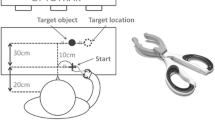Abstract
The kinematic changes associated with the manipulation and transport components during a prehensile movement were examined using an experimental paradigm that required alterations in only the manipulation component. Instead of starting with the thumb and index finger naturally together (control condition), subjects began the reach-to-grasp movement with their thumb and fingers fully extended (experimental condition). In contrast to the control condition, in the experimental conditions the thumb and index finger started to close during wrist transport, then opened again prior to object grasp. In addition, there was a brief inflection in the ascending portion of the velocity profile of the wrist in over half the trials. However, all the primary features of the transport component profile remained unaltered. The results suggest that there can be substantial reorganization of the grip aperture during the first part of the reach without altering the temporal and spatial relationships between grip aperture and transport as the object to be grasped is approached.
Similar content being viewed by others
References
Bootsma RJ, Marteniuk RG, MacKenzie CL, Zaal FTJM (1994) The speed-accuracy trade-off in manual prehension: effects of movement amplitude, object size and object width on kinematic characteristics. Exp Brain Res 98:535–541
Castiello U, Bennett KMB, Paulignan Y (1992) Does the type of prehension influence the kinematics of reaching? Behav Brain Res 50:7–15
Castiello U, Bennett KMB, Stelmach GE (1993) Reach to grasp: the natural response to perturbation of object size. Exp Brain Res 94:163–178
Chieffi S, Gentilucci M (1993) Coordination between the transport and the grasp components during prehension movements. Exp Brain Res 94:471–477
Faugier-Grimaud S, Frenois C, Stein DG (1978) Effects of posterior parietal lesions on visually guided behavior in monkeys. Neuropsychologia 16:151–168
Gentilucci M, Chieffi S, Scarpa M, Castiello U (1992) Temporal coupling between transport and grasp components during prehension movements: effects of visual perturbation. Behav Brain Res 47:71–82
Haaxma R, Kuypers HGJM (1975) Intrahemispheric cortical connections and visual guidance of hand and finger movements in the rhesus monkey. Brain 98:239–260
Haggard P, Wing AM (1991) Remote responses to perturbation in human prehension. Neurosci Lett 122:103–108
Hoff B, Arbib MA (1993) Models of trajectory formation and temporal interaction of reach and grasp. J Motor Behav 25:175–192
Jakobson LS, Goodale MA (1991) Factors affecting higher-order movement planning: a kinematic analysis of human prehension. Exp Brain Res 86:199–208
Jeannerod M (1981) Intersegmental coordination during reaching at natural visual objects. In: Long J, Baddeley A (eds) Attention and performance IX. Erlbaum, Hillsdale, pp 153–168
Jeannerod M (1984) The timing of natural prehension movements. J Mot Behav 16:235–254
Jeannerod M, Biguer B (1982) Visuomotor mechanisms in reaching within extrapersonal space. In: Ingle DJ, Goodale MA, Mansfield RWJ (eds) Analysis of visual behavior. MIT Press. Cambridge, Mass, pp 387–409
Marteniuk RG, MacKenzie CL, Jeannerod M, Athenes S, Dugas C (1987) Constraints on human arm movement trajectories. Can Psychol 41:365–378
Marteniuk RG, Leavitt JL, MacKenzie CL, Athenes S (1990) Functional relationships between grasp and transport components in a prehension task. Hum Mov Sci 9:149–176
Milner TE (1992) A model for the generation of movements requiring endpoint precision. Neuroscience 49:487–496
Paulignan Y, MacKenzie C, Marteniuk R, Jeannerod M (1990) The coupling of arm and finger movements during prehension. Exp Brain Res 79:431–435
Paulignan Y, Jeannerod M, MacKenzie C, Marteniuk R (1991a) Selective perturbation of visual input during prehension movements. 2. The effects of changing object size. Exp Brain Res 87:407–420
Paulignan Y, MacKenzie C, Marteniuk R, Jeannerod M (1991b) Selective perturbation of visual input during prehension movements. 1. The effect of changing object position. Exp Brain Res 83:502–512
Saling M, Mescheriakov S, Molokanova E, Stelmach GE, Berger M (1996) Grip reorganization during wrist transport: the influence of an altered aperture. Exp Brain Res 108:493–500
Stelmach GE, Castiello U, Jeannerod M (1994) Orienting the finger opposition space during prehension movements. J Motor Behav 26:178–186
Taira M, Mine S, Georgopoulos AP, Murata A, Sakata H (1990) Parietal cortex neurons of the monkey related to the visual guidance of hand movements. Exp Brain Res 83:29–36
Von Hofsten C (1979) Development of visually directed reaching: the approach phase. J Hum Mov Stud 5:160–178
Wallace SA, Weeks DL, Kelso JAS (1990) Temporal constraints in reaching and grasping behavior. Hum Mov 9:69–93
Author information
Authors and Affiliations
Rights and permissions
About this article
Cite this article
Timmann, D., Stelmach, G.E. & Bloedel, J.R. Grasping component alterations and limb transport. Exp Brain Res 108, 486–492 (1996). https://doi.org/10.1007/BF00227271
Received:
Accepted:
Issue Date:
DOI: https://doi.org/10.1007/BF00227271




